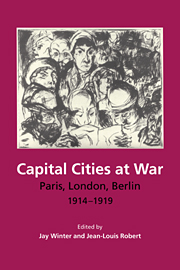Book contents
- Frontmatter
- Contents
- Note on joint authorship
- List of figures
- List of tables
- Part 1 Premises
- Part 2 The Social Relations of Sacrifice
- Part 3 The social relations of labour
- Part 4 The social relations of incomes
- Part 5 The social relations of consumption
- Part 6 Urban demography in wartime
- Part 7 Towards a social history of capital cities at war
- 17 Conclusions: towards a social history of capital cities at war
- Statistical appendix and tables
- Bibliography
- Index
17 - Conclusions: towards a social history of capital cities at war
Published online by Cambridge University Press: 15 December 2009
- Frontmatter
- Contents
- Note on joint authorship
- List of figures
- List of tables
- Part 1 Premises
- Part 2 The Social Relations of Sacrifice
- Part 3 The social relations of labour
- Part 4 The social relations of incomes
- Part 5 The social relations of consumption
- Part 6 Urban demography in wartime
- Part 7 Towards a social history of capital cities at war
- 17 Conclusions: towards a social history of capital cities at war
- Statistical appendix and tables
- Bibliography
- Index
Summary
The conclusions we present in this volume rest at an intermediary point in our study. We have chosen initially to privilege the material conditions of the lives of the inhabitants of these three cities, the new social relations and hierarchies which they constructed, and the representations they themselves gave to their wartime reality. These matters point forward to the focus of volume II: towards an appreciation of the wartime reactions and perceptions of families, social groups, and social movements.
We offer first in this conclusion some reflections on the historiographical context in which to locate our work. We then consider, from a critical and methodological point of view, the central conclusions of this volume on which rests our understanding of the urban experience of warfare in these three cities. Finally, we anticipate how the material in the second volume of this study in comparative social history will complement and extend what we have presented here. Introduction: the historiographical debate
Introduction: the historiographical debate
Our field of study exists at the junction of a chronological history, that of the Great War, and a thematic history, that of urban history. In these two domains, there is a vast historical literature. On the Great War, entire libraries exist. In the field of urban history, the differences in the levels and rhythms of urban development in British, German, and French cities are well known, as is the dynamics of the organization of urban space.
- Type
- Chapter
- Information
- Capital Cities at WarParis, London, Berlin 1914–1919, pp. 527 - 554Publisher: Cambridge University PressPrint publication year: 1997
- 1
- Cited by

